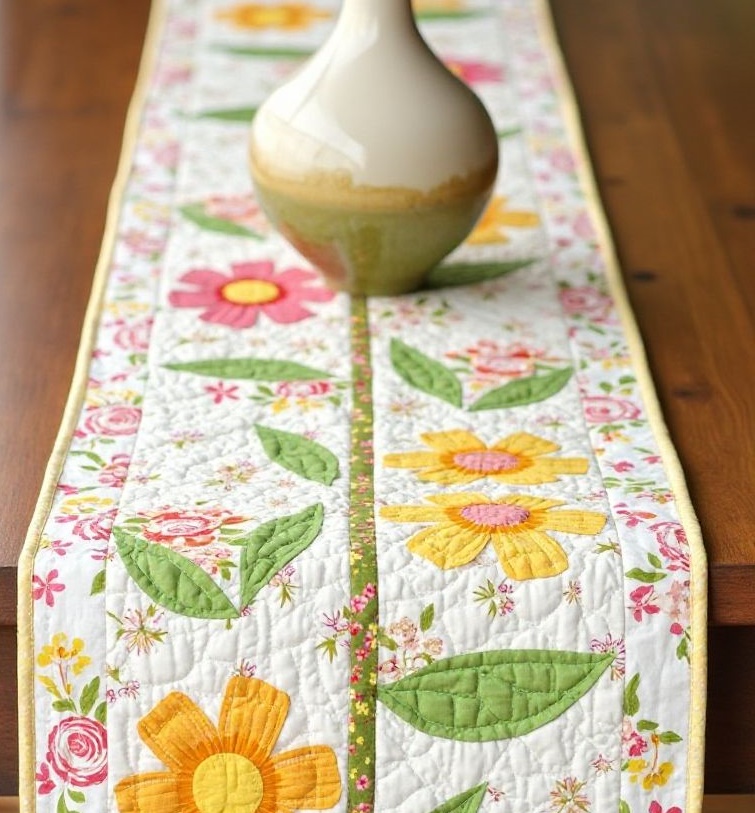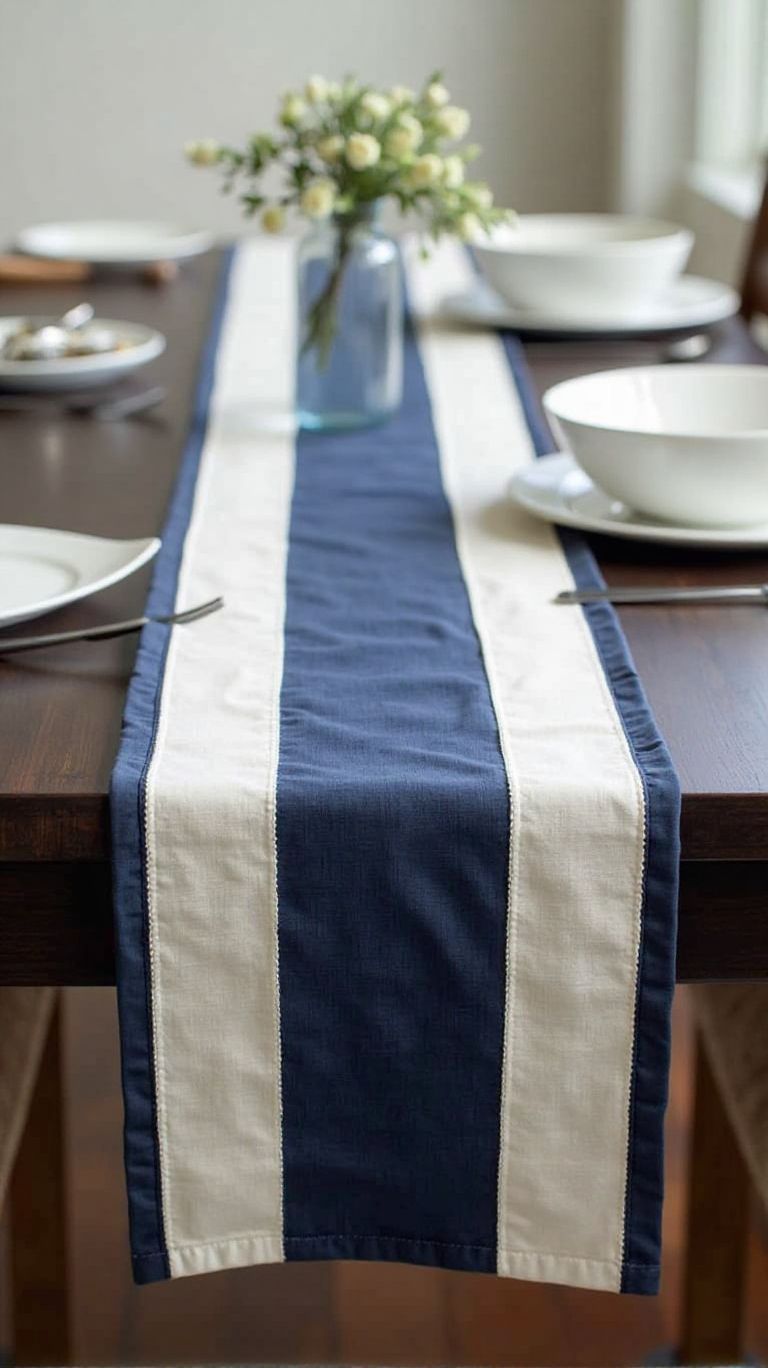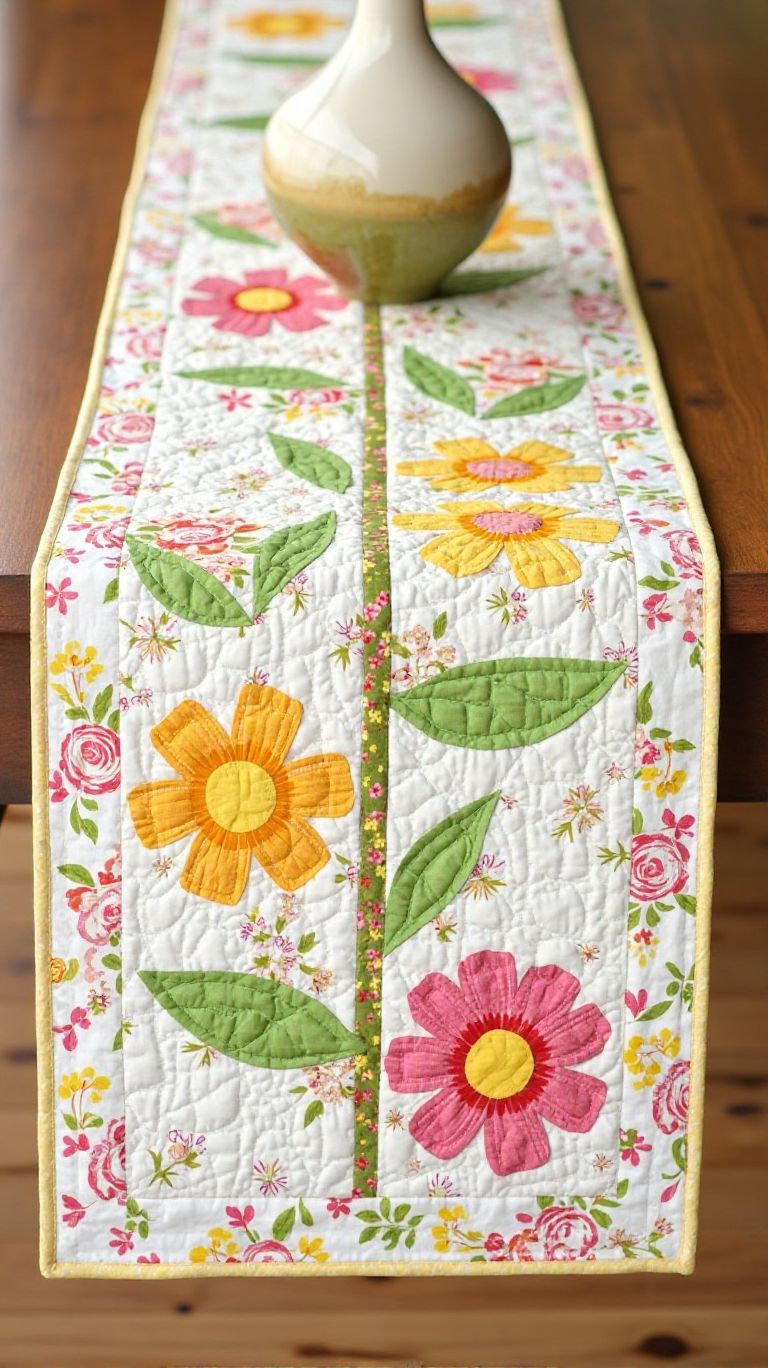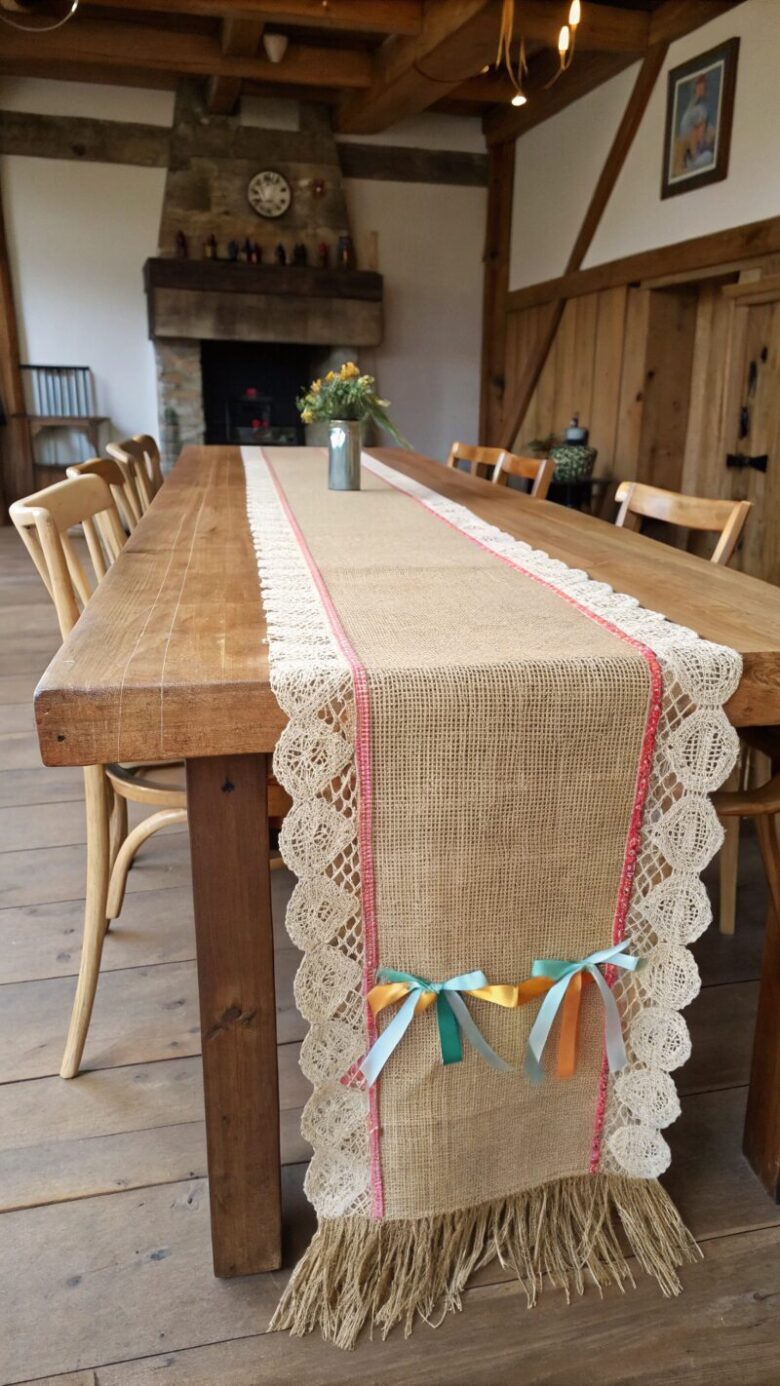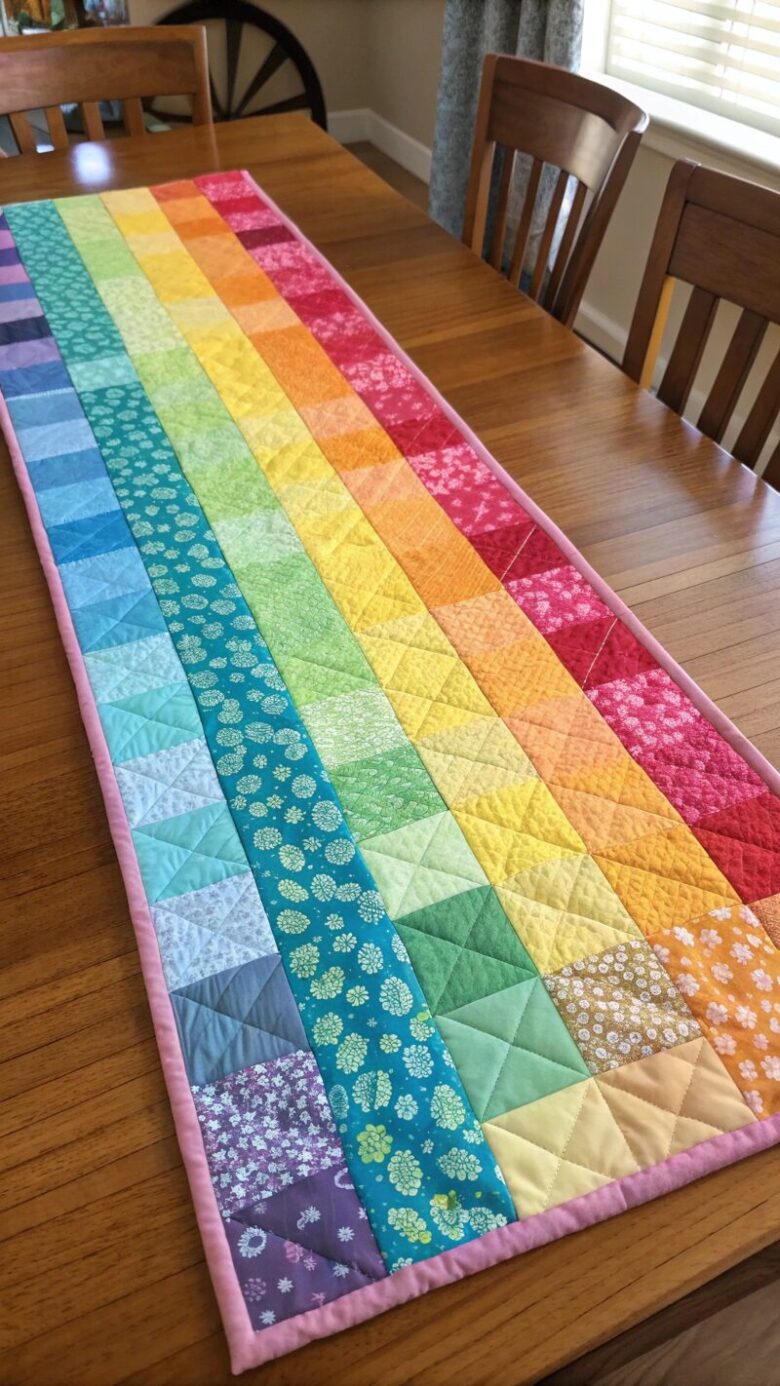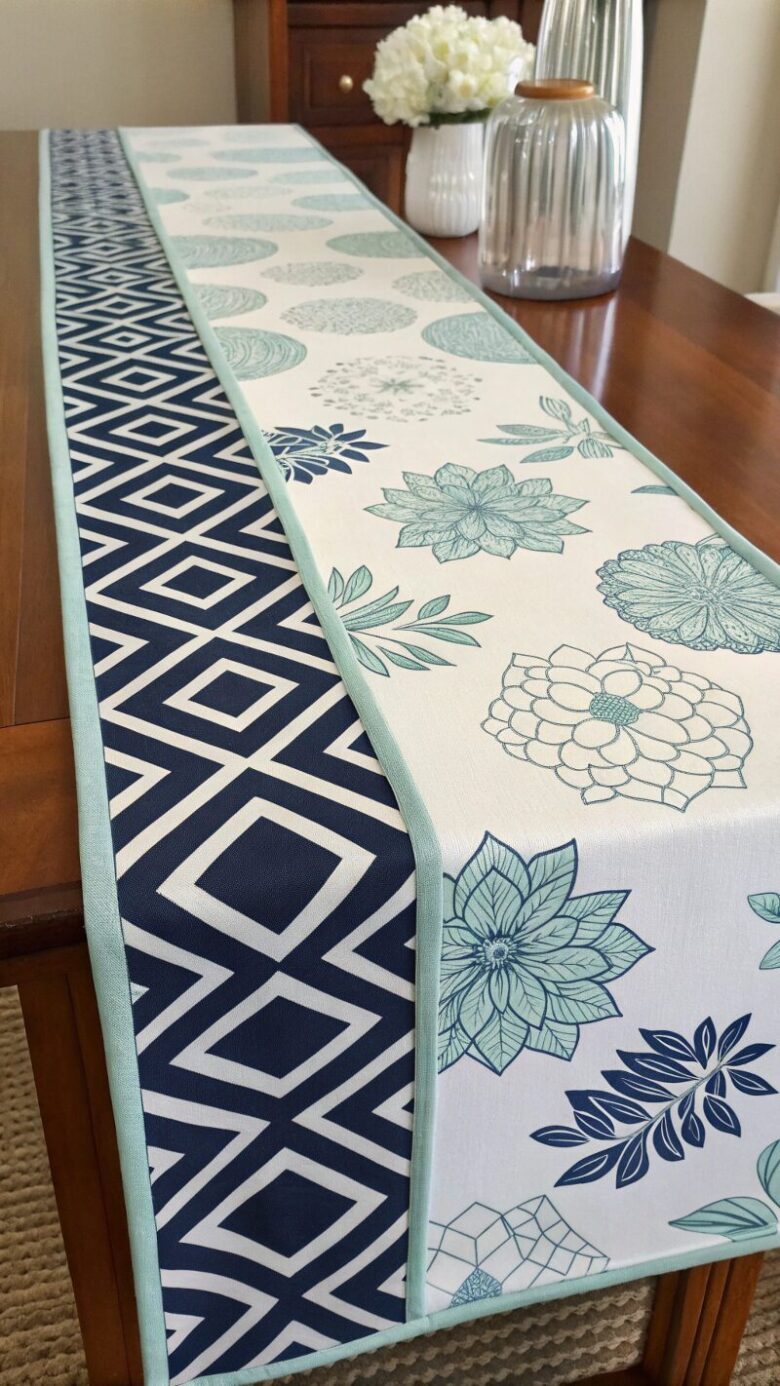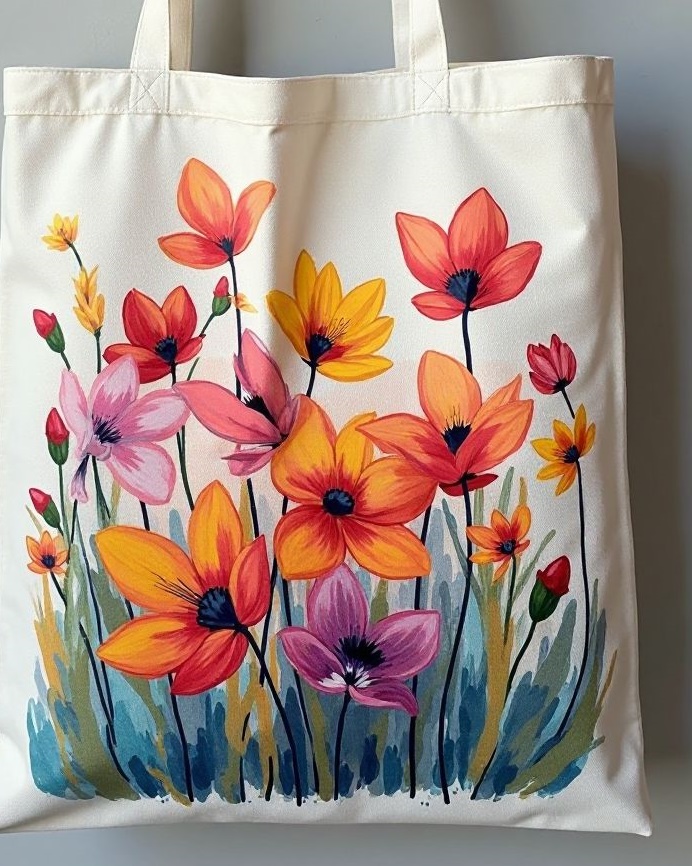I’ve always believed that the dining table is the heart of the home — a place for meals, laughter, and stories. Over the years, I’ve learned that one small detail can completely change the vibe of a table: the table runner. It adds warmth, personality, and a handmade touch that feels so special.
The best part? You don’t need to spend a fortune to create one. I’ve gathered 14 of my favorite free table runner patterns that range from beginner-friendly to advanced designs. Each one lets you explore your creativity while keeping things practical and fun. Whether you want something elegant for guests or cozy for everyday use, these ideas will inspire you to bring new life to your table setup.
So grab your fabric scraps, sewing kit, and a cup of tea — it’s time to stitch something beautiful.
1. Patchwork Charm Table Runner: My Fabric Scrap Hero
This pattern has become my absolute go-to when I’m staring at a pile of leftover fabric squares, wondering what to do with them. There’s something magical about combining different prints into a cheerful mosaic that instantly adds personality to any room.
I remember the first time I made this runner — I used scraps from old quilting projects, including some vintage florals my grandmother had given me. The process was meditative, almost like solving a colorful puzzle. Each square told a story, and together they created something entirely new.
The beauty of this pattern lies in its forgiving nature. If you’re new to sewing, don’t worry about perfect seams or matching colors. The charm is in the imperfection, the way different textures and patterns play together. I’ve made several versions now, and each one reflects a different chapter of my crafting journey.
2. Simple Stripes Runner: Where Elegance Meets Simplicity
When I first started making table runners, this striped pattern was my training wheels. Perfect for beginners, it uses long fabric strips in alternating shades, creating something that looks professionally made without requiring advanced skills.
I’ll never forget making my first striped runner for a dinner party. I chose navy blue and cream cotton, thinking I was playing it safe. But when I laid it on my dark wooden table with white dishes, the effect was stunning. My guests couldn’t believe I’d made it myself.
The key to success with this pattern is in the fabric selection. I’ve learned that contrasting colors create drama, while similar tones offer subtle sophistication. The best part? You can finish this project in an afternoon, making it perfect for last-minute decorating needs.
3. Quilted Garden Blooms Runner: When Spring Lives on Your Table
If you love quilting like I do, this floral-inspired design will make your heart sing. The patchwork flowers add charm to your spring or summer table, bringing the garden indoors even on the dreariest days.
I created my first garden blooms runner during a particularly long winter. I was desperate for color and life in my dining room, so I gathered every floral fabric I owned — some bright yellows, soft pinks, and cheerful greens. As I pieced together each flower block, I could almost smell the roses and feel the warm sunshine.
This pattern requires more planning than some others, but the result is worth every careful stitch. I recommend sketching out your flower arrangement first, playing with color placement until it feels just right. The quilting adds texture and durability, making this runner both beautiful and practical.
4. Minimalist Linen Runner: Timeless Sophistication
Sometimes the most powerful statement is the quietest one. For a modern, clean look, a neutral linen table runner with perfectly hemmed edges never disappoints. It’s chic, timeless, and surprisingly versatile.
I discovered the power of minimalism when I was going through a major life transition. Everything felt chaotic, and I craved simplicity. I made this runner in natural linen, focusing on perfect construction rather than elaborate design. The process was therapeutic, each precise fold and stitch helping me find calm.
This runner has become my most-used piece. It works with everything — from casual family dinners to elegant holiday meals. The natural texture of linen adds warmth without overwhelming other table elements. I’ve made several in different lengths, and they’ve become my go-to gifts for friends who appreciate understated elegance.
5. Rustic Burlap Runner: Embracing the Farmhouse Dream
This pattern gives that farmhouse feel everyone loves, and I have to admit, I fell hard for this trend. There’s something about burlap that instantly makes everything feel more relaxed and welcoming.
My first burlap runner was actually born out of necessity. I was hosting a casual outdoor dinner and wanted something that felt appropriate for the setting. I found some beautiful burlap at a local craft store and decided to experiment. The natural fraying edges worried me at first, but I learned to embrace them as part of the charm.
You can customize this runner in so many ways. I’ve added lace trim for a softer look, used colorful ribbon for a pop of color, and even tried stenciling simple designs. The key is not to overthink it — burlap has its own personality, and sometimes the best approach is to let it shine.
6. Scrappy Rainbow Runner: Sustainability Meets Joy
Bright, joyful, and sustainable — this pattern uses all your fabric scraps in rainbow order, and it’s become one of my favorite ways to reduce waste while creating something beautiful.
I started making scrappy runners when I realized how many small fabric pieces I was throwing away. It felt wasteful and sad. So I began collecting every scrap in a large basket, organizing them by color. When I had enough, I created my first rainbow runner.
The process is incredibly satisfying. There’s something about working through the color spectrum that feels almost therapeutic. I start with deep reds and work my way through oranges, yellows, greens, blues, and purples. Each transition creates a visual journey across the table.
This runner always makes people smile. It’s impossible to look at it without feeling a little happier, and knowing that it’s made entirely from scraps that would have been wasted makes it even more special.
7. Holiday Sparkle Runner: Celebrating in Style
Made with festive prints, this pattern brings out the holiday spirit like nothing else. I’ve learned that adding metallic thread during construction creates a subtle shimmer that catches candlelight beautifully.
My love affair with holiday runners began when I was newly married and hosting my first Christmas dinner. I wanted everything to be perfect, but my budget was tight. I found some gorgeous red and gold holiday fabric on clearance and decided to make my own runner.
The key to a successful holiday runner is balancing festive elements without going overboard. I’ve made versions for different holidays — warm oranges and browns for Thanksgiving, pastels for Easter, red and pink for Valentine’s Day. Each one helps transform the dining room for the season.
8. Appliqué Leaf Runner: Where Art Meets Function
This pattern represents a creative fusion of fabric work and artistic expression. Stitching leaf shapes onto a solid base creates a lovely nature-inspired centerpiece that works year-round.
I developed this technique when I wanted to capture the beauty of autumn leaves but in a way that would last beyond the season. I collected real leaves from my yard, used them as templates, and cut shapes from various brown, gold, and orange fabrics.
The appliqué process requires patience, but it’s incredibly meditative. I love the way each leaf can be slightly different, just like in nature. Some I’ve embellished with decorative stitching to show leaf veins, others I’ve left simple. The variety creates visual interest and feels authentic.
9. Reversible Runner: Two Looks, One Project
Why settle for one look when you can have two? This reversible design has revolutionized how I think about table decoration. I can flip between patterns depending on the season, my mood, or the occasion.
My first reversible runner was born out of indecision. I couldn’t choose between two fabrics I loved, so I decided to use both. One side featured a bold geometric print in navy and white, while the other showcased a delicate floral in soft blues and greens.
The construction requires more planning and precision, but the versatility makes it worthwhile. I now have several reversible runners, and they’ve become conversation starters. Guests often notice the pattern and ask about the other side, giving me a chance to flip it and show off both designs.
10. Vintage Doily Runner: Upcycling with Romance
Upcycling old doilies into a romantic, lacey runner feels both vintage and classy — perfect for afternoon tea or intimate dinner parties. This project helped me connect with my grandmother’s legacy in a meaningful way.
I inherited a box of doilies from my grandmother, beautiful pieces that had been tucked away in storage for years. Rather than letting them continue collecting dust, I decided to give them new life as a table runner. The process felt like a collaboration across generations.
The technique involves carefully joining the doilies with nearly invisible stitches, creating a cohesive piece while preserving each doily’s individual character. I’ve added simple fabric backing for stability, but the lace remains the star. Every time I use this runner, I think of my grandmother and the hours she spent creating these delicate treasures.
11. Chevron Delight Runner: Geometric Grace
Chevron stripes never go out of style, and I’ve discovered that mixing contrasting fabrics creates a bold, trendy look that works in both traditional and modern settings.
My chevron runner journey began when I fell in love with a geometric wallpaper pattern but couldn’t afford to redecorate my dining room. Instead, I decided to bring that energy to my table through fabric. I chose charcoal gray and cream for a sophisticated look that would coordinate with my existing decor.
The key to successful chevron construction is precise cutting and careful piecing. I’ve learned to take my time with measurements and use plenty of pins. The result is worth the extra effort — clean lines that create visual movement and interest without overwhelming the space.
12. Stenciled Paint Runner: For the Non-Sewers
If sewing isn’t your thing, you can still create beautiful table runners using fabric paint and stencils. This technique opened up runner-making to friends who felt intimidated by traditional sewing methods.
I developed this approach when a friend admired my handmade runners but insisted she “couldn’t sew to save her life.” Together, we created her first runner using plain canvas and fabric paint. We chose a simple star pattern and worked in soft blues and whites.
The process is forgiving and creative. You can layer colors, create gradients, or stick to simple single-color designs. The painted fabric has a unique texture and feel that’s different from sewn pieces but equally beautiful. My friend was so proud of her creation that she immediately started planning her next painted runner.
13. Denim Patch Table Runner: Sustainable Style
Cutting up old jeans and transforming them into a rugged, modern denim runner combines sustainability with style in the most satisfying way. This project has become my go-to for using worn-out denim that’s too good to throw away.
The idea came to me when I was cleaning out closets and found several pairs of jeans that no longer fit or had worn beyond repair. Instead of donating them, I decided to give them new life. I cut them into squares and rectangles, creating a patchwork pattern that celebrated the natural variations in denim color and texture.
Working with denim requires heavy-duty needles and patience, but the result is incredibly durable. The runner improves with washing, becoming softer and more comfortable over time. It’s perfect for casual family meals and adds an unexpected twist to more formal settings.
14. Ruffled Edge Runner: Romance and Elegance
Adding ruffled edges brings softness and elegance to any table runner, making it perfect for weddings, romantic dinners, or any time you want to add a touch of femininity to your table.
I first experimented with ruffles when making a runner for my daughter’s baby shower. I wanted something soft and romantic that would complement the pastel color scheme. The ruffles added movement and visual interest, creating a sense of celebration even before the guests arrived.
The technique requires gathering fabric carefully to create even ruffles, but the effect is magical. I’ve used this technique on various base patterns, from simple solid fabrics to complex patchwork designs. The ruffles seem to elevate everything, adding a custom, professional touch that makes guests feel special.
Conclusion: Your Table, Your Story
Each of these free table runner patterns offers something unique — a chance to express your creativity, use materials you already have, and bring handmade warmth to your dining space. What I’ve learned through making dozens of runners is that the process is just as rewarding as the result.
Every runner tells a story. The scrappy rainbow runner reminds me of my commitment to sustainability. The vintage doily runner connects me to my grandmother’s legacy. The simple striped runner takes me back to my early days of learning to sew.
Once you start making your own table runners, you’ll never look at a plain table the same way again. You’ll begin to see possibilities everywhere — in fabric scraps, old clothing, even forgotten linens tucked away in closets. More importantly, you’ll discover that the act of creating something beautiful for your home is a gift you give not just to your family and guests, but to yourself.
So choose a pattern that speaks to you, gather your materials, and begin your own table runner story. I promise you’ll be amazed at what your hands can create and how much joy a simple length of fabric can bring to your daily life.

